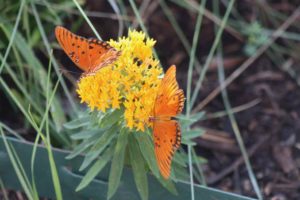

by Lydia Holley March 14, 2022
Since milkweed is the host plant for monarch butterflies, it is famous for attracting them. However, milkweed’s nectar draws numerous other species of butterflies, too. So, if you plant it, you will have butterflies come to your garden. Butterfly weed (Asclepias tuberosa) is a low-growing bright orange milkweed, which is considered perennial and will also reseed. According to Lady Bird Johnson Wildflower Center, this milkweed has no milk sap. Native to East Texas, this milkweed makes a colorful addition to your garden with or without butterflies on it.
If you do not care for orange, consider growing antelope horn milkweed (Asclepias asperula) which has a white or light green bloom. It also stays short. Very similar is green milkweed (Asclepias viridis).
Although most gardeners plant milkweed to attract butterflies, it also makes a good cut flower. So, plant extra to bring some inside to add to your cut flower bouquets.
Should you prefer a taller milkweed, tropical milkweed (Asclepias curassavica) will reach at least four feet tall. Monarchs and other butterflies will flock to this milkweed’s red and yellow flowers.
Mexican hats (Ratibida), also known as prairie coneflowers, are unmistakable. They bloom on long stems and have a tall disc in the middle which rises up to two inches above drooping petals. This gives butterflies a lot of room to land upon. They come in various colors, ranging from red to yellow and all the orange shades in between. A perennial, Mexican hats are considered highly deer resistant. They are also native to East Texas.
Collect the seeds from your Mexican hat plants and broadcast them in the fall. Be aware that first year plants may not flower, so be patient and you will soon have a nice section of these plants.
For more information, call 903-675-6130, email hendersonCMGA@gmail.com.
Follow us on Facebook: https://www.facebook.com/HCmastergardener.